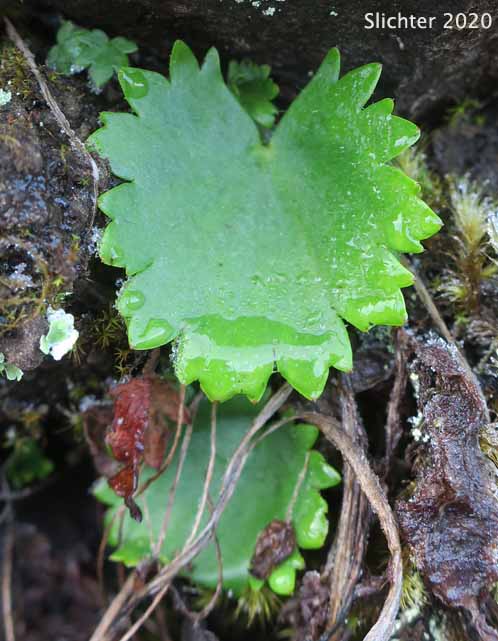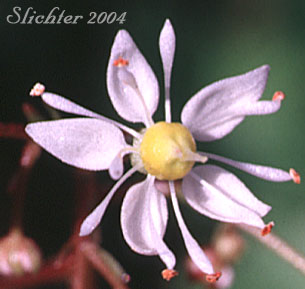 A close-up of a leaf of Merten's saxifrage observed along the now naturescaped haul road on the west bank of the Klickitat River several miles north of Washington Highway 142.......November 28, 2020.
A close-up of a leaf of Merten's saxifrage observed along the now naturescaped haul road on the west bank of the Klickitat River several miles north of Washington Highway 142.......November 28, 2020.
Merten's saxifrage is a perennial wildflower with flowering stems arising 15-40 cm high above numerous basal leaves which sit atop short thick rhizomes which often bear bulblets. The stems often have 1-3 small leaves near their base, but above the basal leaves. The herbage is smooth to having long, soft, spreading hairs or glands on the stem. The succulent leaves are large and round with large teeth on the margins (See photo at right.). The teeth which sometimes overlap are incised up to one-quarter of the distance into the blade. The hairy leaf petioles are 1-4 times longer than the blades which are 3-5 cm wide and nearly as long. The hairs of the petiole are long, soft and spreading and may be gland-tipped.
The inflorescence is an open cyme or panicle, with many flowers. Some of the flowers may be replaced by pink bulblets. The 5 petals are white, oblong-elliptic to obovate in shape, narrowing abruptly to a short-clawed base (See photo below.). The petals are each about 3-5 mm long with the tips tapering gradually to a point. The calyx is cleft nearly to the base, with each of the 5 lanceolate to lanceolate-oblong lobes reflexed outwards. The calyx lobes measure up to 3 mm long. The stamens are roughly equal in length to the petals with pink anthers. The filaments are narrowly club-shaped. The ovary is nearly superior with the two short styles diverging. The capsule is 4-5 mm long and united for more than half the length.
The unique and attractive foliage would make Merten's saxifrage an interesting wildflower for shaded, rocky or streamside gardens or perhaps on moist rock walls. The foliage will probably die back and disappear by mid-summer.
Brook Saxifrage Saxifraga odontoloma (formerly S. arguta): The stems and leaf petioles are rarely pilose and are generally glabrous to covered with shorter hairs. The stems are usually leafless. The margins are not double-toothed and not incised as deeply as those of Merten's saxifrage. The petals are rounder than those of Merten's saxifrage, although they may be unequal in shape. The petals of brook saxifrage often have 2 yellow spots at their base. Typically found in wet, subalpine to alpine meadows and along streams.

Merten's saxifrage may be found on wet shady cliffs or along streams.
Merten's saxifrage may be found from southern Alaska south between the coast and the Cascade crest to the central Sierra Nevada of California. In British Columbia, it extends eastward to northwest Montana and south through central Idaho to the Blue Mts. and Wallowa Mts. of north-central and northeastern Oregon.